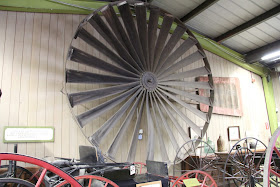My first choice was the A. A. Cooper car shown above. I liked the billboard look of the car. It was also 40 feet long, a typical size for carriage and furniture cars of the period. This was due to the fact that the loads they carried were relatively light for the volume so they could build larger cars without increasing the stress on the timbers and trucks. Decals were by Art Griffin.
My second car was to be a Southern Pacific furniture and buggy car, also a 40-footer, and one for which I had original drawings. It was the car which the SP used to represent the maximum height and width for travel over Donner Pass. It was large enough that the bolsters were lowered to keep the total height down. Notice how the body sort of nestled over the trucks similar to the apearance of some narrow gauge cars. I had the decal set for the Cooper car, some SP heralds left over from another project and the rest was not difficult to make up. While I was rummaging through my decal drawer, I found a few more decals and thought I might as well build up some of them, all of which were larger cars. This led to the following cars.
The Abernathy Furniture Company was a Kansas City concern whose building still exists in the West Bottoms area of the city. According to some documents I have, these cars made it out to California in the 1890s so it was appropriate for use on the S&C. Decals for this car were also made by Art Griffin.
The Santa Fe cars also appeared in California and, since several of my operators are Santa Fe fans, I decided to include it. It rode on Thielsen swing-motion trucks. More Griffin decals.
The Samuel Cupples car was 50 feet long and another car which was extra high. Here was another manufacturer who used all the "billboard" space he could. I guess he thought bigger was better. More of Art Griffin's work.
The C. C. Comstock car was one which has intrigued me ever since I saw a photo in poor condition. Mr. Comstock was again one of those who liked advertising and apparently multi-colored paint jobs and fancy lettering. Applying the decals was somewhat exacting but they came out to my satisfaction which is what matters.
While going through this, I found another large car, the Menasha Woodenware 50-foot long car described as the tallest freight car built (of the period anyway). It was a kit made by Main Line Models and one I had forgotten I had. Since it fit with the theme of large car construction, I assembled it as well. Interestingly enough, one of these cars was restored or reconstructed and donated to the National Railroad Museum so you can visit it if you like. These cars, too, made it out to California.
While a 50-foot car seems like no great shakes in the context of modern railroading, these "monsters" as they were sometimes called gave rise to editorials questioning the wisdom of such large cars on the railroads. To give an idea of what they were talking about, take a look at the photo below comparing a standard 34-foot car to the Menasha car. There was a lot of difference, especially in high winds. And, yes, there were even larger 60- and 70-foot wood cars tried out before the car builders wisely changed to steel construction.















